South by West- camping from Alaska to Nicaragua
3- In Mexico
Kilometre 21; Mexican roads; Tope speed bumps; Driving into sunset; Pemex gas stations; Bahia de Kino campground; Montezuma revenge; Dogs in Mexico; Pangas
-------------------------------------------------------------
Suddenly we were driving through Nogales, Sonora, Mexico, through a foreign town, streets crowded with people, beat up cars, strange shops, signs, music and unfamiliar smells. Where was the immigration, what happened to the paperwork? Visitor's permit, temporary vehicle registration, copies of drivers licence etc.?? When I saw a policeman standing at the corner I pulled over and tried for the first time my Spanish. I could communicate with him, but the only thing I understood well was "kilometre veinte uno -21". What is Kilometre 21?? We kept driving, counting kilometres.
Well, you couldn't miss Kilometre 21. This was the real entry into Mexico. The Immigration, Customs, Insurance etc. was 21 km INSIDE the country. Parking lots were full and lines long. And moving VERY slowly. Took 4 hours to get to the window, to have our papers checked, credit card imprinted, entered into the computer [it went down a few times] and issued windshield sticker. Nobody asked for a bribe or gave us hassle. It was just slow, only 4 wickets were opened. [The guide book said that Nogales is the best and fastest border crossing. Maybe we picked the wrong day!]
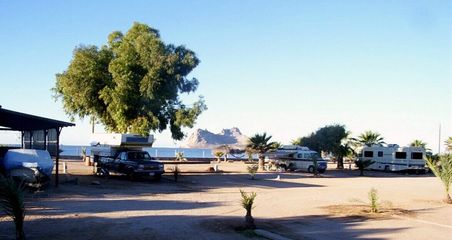
...Islandia Campground in Kino Viejo was tranquil in November. Next month it was jammed with big rigs...
By 4 o'clock we are back on the road. The four lane toll highway varies between good and very good with only a few bad sections full of potholes. The road is repaired by adding another layer of asphalt on top of the pavement, but not on the shoulder. Consequently, the pavement is 3"-4" above the narrow gravel shoulder and then there is the deep ditch. It is difficult to pull off to the side of the road and driving off the pavement could be deadly. There are many white crosses, decorated with flowers beside the highway, sometimes clusters of 2 or 4, indicating how many people were killed at that spot. Counting crosses becomes a morbid entertainment.
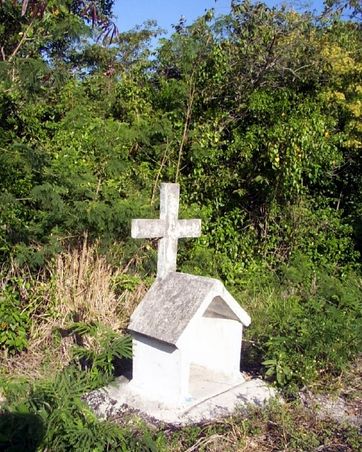
...fatal accident is marked with a cross. It could be a wooden or metal cross or little concrete shrine......
Sides of the road are full of garbage and once in a while a dead, mummified cow decorates the side. Speed through towns is controlled by big speed bumps called "Tope" that everybody approaches at crawl speed. Many are not marked by speed bump sign and hitting Tope at low speed is scary and at faster speed Tope becomes a catapult.
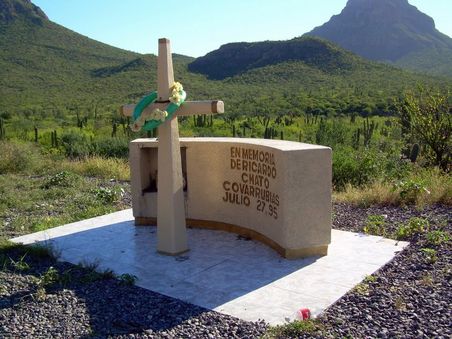
...or a monument for loving father...
We were driving west, directly into a blinding sunset. I slowed down looking for place to pull out, but cars and trucks were passing me, ignoring the bright, blinding sun. Luckily there was a rare rest stop/ garbage dump in a curve where we could stop.
"Do not drive after dark in Mexico!", we were advised at Kilometre 21. And this was exactly what we were doing on our first day in Mexico. It was getting dark, we were on the road, not having a clue where to go, where to spend the first night. We were driving through Santa Anna watching out for topes and BINGO! There was a sign "RV Park" and we pulled in for the night. It was run by Eduardo, a nice guy who spoke good English and limped very badly because of mangled leg " I was young, crazy and had a motorcycle, very bad combination. It was 27 years ago...... " he told us.
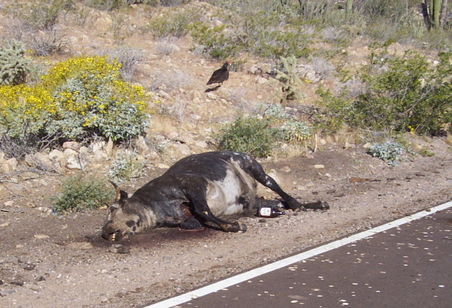
......but some victims a left to rot beside the highway.....
There were 11 vehicles in the RV park ranging from a huge RV bus to an old camper van. One couple with 5th wheel sold their house 7 years ago and were "drifting" -their words- between Guatemala and Yukon. The old camper van belonged to Joe and Carroll from Kentucky. They have been going to Mexico for some 20 years and became out mentors. They gave us tips how to buy gas, how to shop, where to camp in Mexico and traded us an old Lonely Planet travel guide to Mexico.
The next day we went to the Pemex gas station, a strange experience for Canadian driver. Two or three guys were hanging out at the station and each tried to wave us to his pump. The payment was cash only. Diesel pumps had only a big nozzle that wouldn't fit the tank of our truck and fill up was slow. Pemex was the only oil company in Mexico and prices of fuel were the same everywhere, no need to look for cheaper gas. "You should give a tip" So I gave the attendant a tip, big shiny coin; could not see the number but it looked cheap. Back in the truck I found out it was 10 pesos, about $1.75!! Time to learn values of Mexican coins.
Pemex gas stations were big, modern, washrooms clean, some had convenient store, but none sold road maps!
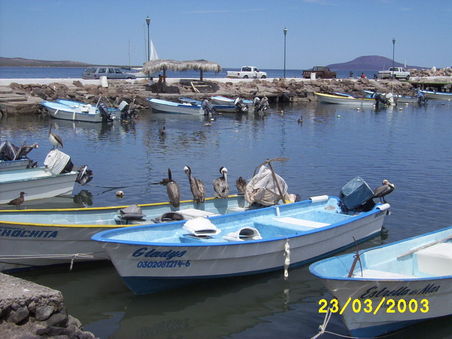
...Pelicans and Pangas...
Bahia De Kino was the closest town to the Sea of Cortez according to the one page map of Mexico in the back of Rand Road Atlas, so we were heading there. Hermosillo, the capital of Sonora gave us the taste of driving in large city. Traffic was heavy, streets and road signs were poorly marked. We missed the highway turn off and had to backtrack, blundering through side streets. Carretera #10 was a narrow, straight, paved highway going through a parched land, with the usual assortment of garbage. Suddenly there was a huge grove of green lemon trees with a few buildings and houses, completely out of place. Then we were in a dusty town with speed bumps, kids in uniforms walking from schools, assortment of broken cars beside the road, several stores and outdoor eateries. Then we were driving again through the desert with occasional cactus and then more groves with green trees and fields. The green color was so bright here.
Bahia De Kino is named after a Jesuit priest, Father Eusebio Kino, who established a mission there for the Seri Indians in 17th century. The town is divided into a Kino Viejo [old] and Kino Nuevo. The latter is " a haven for American retirees who have created a secluded, sanitized version of the States behind a fenced in, faux-villa facade" according to Berkeley Guide.
We run again into Joe and Carroll and head together to Islandia Park campground in Kino Viejo. Only few campsites were occupied and we picked a premium site with a lonely, shady tree for 100 pesos per night with hydro and water. The beach was behind a low wall, topped with barbed wire. The beach was clean, water clear, blue and cold. Offshore, you could see many shrimp boats anchored behind a scenic Pelicano island. The washrooms had showers and flush toilets. Sign in the washroom: "Please put the toilet paper in the waste basket." Easy said but, hard to break the old habit. Apparently sewer lines were too small and toilette paper would plug them.
Kino Viejo is a village of maybe 4000 people. Few of the main streets are paved. Side streets are sandy, dusty, with old concrete block houses. Every street seems to have an assortment of barbecue eateries. People are hanging out on the streets, friendly, wave back. Dogs of different shapes, sizes and state of health prowl streets. Overall feeling is that Kino Viejo is an old, friendly, safe place, with good cooked food.
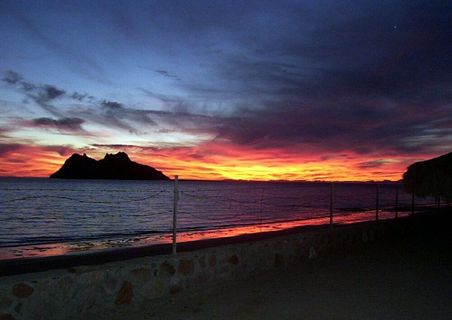
...Dusk at Isla Pelicano...
We consulted Joe and Carroll about Montezuma revenge "Don't worry, it attacks mostly the 2 week-package tourist, that tries to get drunk, sunburned and gorged on free hotel food." Since we don't belong to that category, we went to check out one pescaderia. Three pieces of barbecued fish with tortillas and salad cost 45 pesos, about $7. It was excellent with no later side effects.
Two dogs hung around our site. One was old and limped on three legs, the other was slim, friendly with white, short hair. Did they belong to the campground, a Mexican house or were abandoned? Sue felt sorry for them and tried to give them tortilla. They would not touch it so she bought dog food. They would not eat it either, but did not mind a piece of fish. At night there was a big dog serenade around the town. It started at one end of the town and barked and howled its way to the other. Have not seen any aggressive dogs. Well, we did, they were dead along the road, killed by cars, and so by a natural selection only friendly dogs lived here.
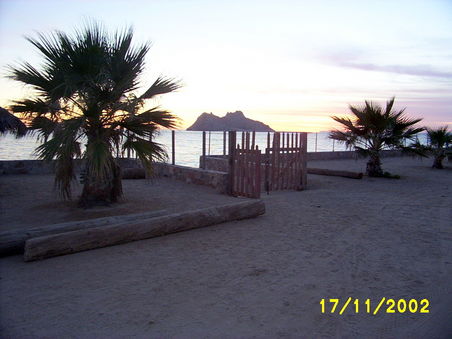
...a hurricane wiped out all trees in Islandia. New palms are growing on old tree stumps...
Few peddlers came to the camp every day selling fish, food or wood carvings. Shy kids selling cookies, woman with three small kids selling delicious tamales- corn dough stuffed with meat, beans and chiles, wrapped in corn husks. We befriended Felix a Seri Indian who made beautiful carvings from iron wood. He hitchhiked from his village once or twice a week [28km] to sell carvings. We gave him a ride to Kino Nuevo and he showed us around. Expensive and very expensive houses, owned by Americans and rich Mexicans were stretched along the beach for 5 km. Kino Nuevo was clean, nice looking and dead. Locals lived in Kino Viejo. Dusty streets made it look old and run down, but it was busy, alive with people [and dogs].
Mexican fishermen used boats called Panga. They were fiberglass boats about 20' long with flared bow, powered by 80+HP outboard, usually Yamaha. The original Panga was built some forty years ago, a project financed by the World Bank, to provide an economical, seaworthy craft for commercial fishermen in Third World countries. They became a true sea workhorse and are used for everything from fishing to drug smuggling.
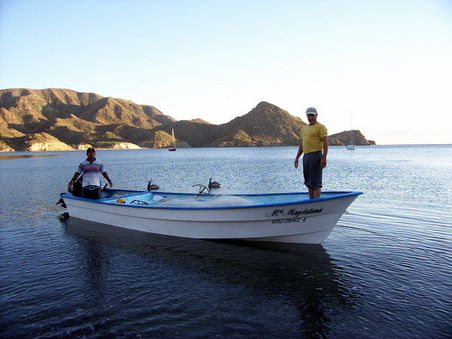
...Panga is very stable and seaworthy boat...
Pangas are buzzing shoreline of Kino Viejo all the time. Many are pulled up on the shore, unloading fish or getting ready to go out. Some have a contraption inside, consisting of rusted compressor, driven by an old, lawn mower motor. Beside is a 5 gallon aluminum beer barrel connected with 1/2" plastic hose to the compressor. Another hose, 50'-80' long, also hooked up to the barrel is coiled up in the bow. Sometimes there is an old flashlight attached to the hose end, with wires running along the hose to a battery in the boat. The fisherman/diver with a Hawaiian sling harpoon dives 20'-30' to the bottom, breathing air through the hose. He crawls along the bottom looking for fish, crabs, conch shells or whatever is there. The compressor must be lubricated, but because the oil is very bad for the lungs, they use dishwasher detergent which is supposed to be less lethal to the diver. We heard that every year someone dies as a result of this type of fishing.
| Start of journey: | January 2003 |
| Duration: | 5 years |
| End of journey: | January 2008 |
Mexico
Guatemala
Belize
